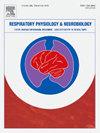Comparison of maximal inspiratory pressure to resistive breathing for weaning prediction
IF 1.6
4区 医学
Q3 PHYSIOLOGY
引用次数: 0
Abstract
Introduction
The effect of MIP on extravascular lung water generation (EVLW) is not known. Our aim was to compare a resistive breathing trial (RBT) to MIP in terms of EVLW generation and in predicting the weaning outcome.
Methods
In patients undergoing a spontaneous breathing trial (SBT) for the first time we compared the EVLW generated, using lung ultrasound (B-lines), during MIP to SBT and RBT; MIP, airway pressure swings during RBT (ΔPawRBT) and its ratio to rapid shallow breathing index during RBT (ΔPaw/RSBI)RBT were assessed as indices of weaning prediction. Additionally, we assessed the relationship of MIP, ΔPawRBT and (ΔPaw/RSBI)RBT to esophageal (Pes) and transdiaphragmatic pressure (Pdi) and the pressure-time product of the Pes (PTPes). Weaning failure was defined as SBT failure or need for reintubation at 48 h.
Measurement and main results
Thirty-three patients were enrolled. B-lines, heart rate and blood pressure were higher during MIP compared to RBT (p < 0.001). ΔPawRBT, (ΔPaw/RSBI)RBT and MIP were higher in patients succeeding weaning compared to those who failed [19.53 cmH2O (±11.91) vs 10.77 cmH2O (±8.94), p = 0.027], [0.16 cmH₂O·L·min⁻¹ (0.16) vs 0.05 cmH₂O·L·min⁻¹ (0.03), p < 0.001)], [41.39 cmH2O (14.59) vs 16.34 cmH2O (20.3), p = 0.002]. ROC analysis showed no difference between MIP and ΔPawRBT or (ΔPaw/RSBI)RBT in predicting weaning outcome; ΔPawRBT and (ΔPaw/RSBI)RBT correlated with Pes, Pdi and PTPes (p < 0.05).
Conclusions
(ΔPaw/RSBI)RBT predicted weaning outcome with similar accuracy to MIP and was associated with less B-lines, HR and BP alterations; RBT-derived airway pressures are a promising novel method for weaning outcome prediction and respiratory muscle strength assessment.
最大吸气压力与阻力呼吸在脱机预测中的比较。
MIP对血管外肺水生成(EVLW)的影响尚不清楚。我们的目的是比较阻力呼吸试验(RBT)与MIP在EVLW产生和预测脱机结果方面的差异。方法:在首次进行自主呼吸试验(SBT)的患者中,我们比较了MIP期间使用肺超声(b线)与SBT和RBT产生的EVLW;评估MIP、RBT期间气道压力波动(ΔPawRBT)及其与RBT期间快速浅呼吸指数(ΔPaw/RSBI)的比值(RBT)作为预测脱机的指标。此外,我们还评估了MIP、ΔPawRBT和(ΔPaw/RSBI)RBT与食管(Pes)和经膈压力(Pdi)以及pe (PTPes)的压力-时间积的关系。脱机失败定义为SBT失败或需要在48小时内重新插管。测量和主要结果:33例患者入组。与RBT相比,MIP期间的b线,心率和血压更高(pRBT, (ΔPaw/RSBI))断奶后患者的RBT和MIP高于失败患者[19.53 cmH2O(±11.91)vs 10.77 cmH2O(±8.94),p=0.027], [0.16 cmH₂O·L·min毒血症(0.16)vs 0.05 cmH₂O·L·min毒血症(0.03),p2O (14.59) vs 16.34 cmH2O (20.3), p=0.002]。ROC分析显示MIP与ΔPawRBT或(ΔPaw/RSBI)RBT在预测断奶结局方面无差异;ΔPawRBT和(ΔPaw/RSBI)RBT与Pes、Pdi和PTPes相关(p结论:(ΔPaw/RSBI)RBT预测断奶结局的准确性与MIP相似,且与较少的b线、HR和BP变化相关;rbt衍生的气道压力是预测脱机结果和评估呼吸肌力量的一种有前途的新方法。
本文章由计算机程序翻译,如有差异,请以英文原文为准。
求助全文
约1分钟内获得全文
求助全文
来源期刊
CiteScore
4.80
自引率
8.70%
发文量
104
审稿时长
54 days
期刊介绍:
Respiratory Physiology & Neurobiology (RESPNB) publishes original articles and invited reviews concerning physiology and pathophysiology of respiration in its broadest sense.
Although a special focus is on topics in neurobiology, high quality papers in respiratory molecular and cellular biology are also welcome, as are high-quality papers in traditional areas, such as:
-Mechanics of breathing-
Gas exchange and acid-base balance-
Respiration at rest and exercise-
Respiration in unusual conditions, like high or low pressure or changes of temperature, low ambient oxygen-
Embryonic and adult respiration-
Comparative respiratory physiology.
Papers on clinical aspects, original methods, as well as theoretical papers are also considered as long as they foster the understanding of respiratory physiology and pathophysiology.

 求助内容:
求助内容: 应助结果提醒方式:
应助结果提醒方式:


